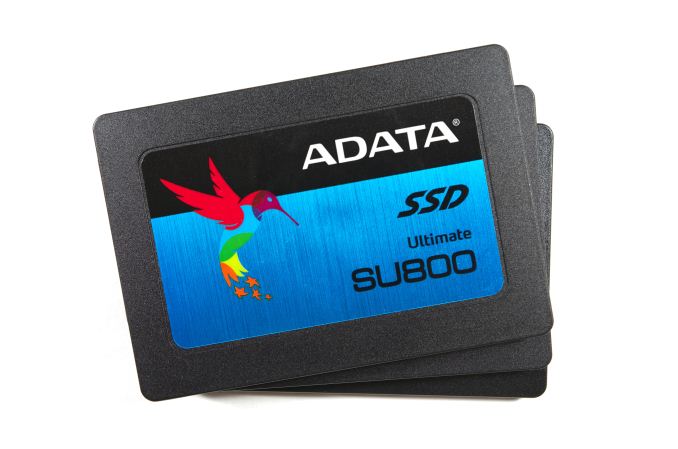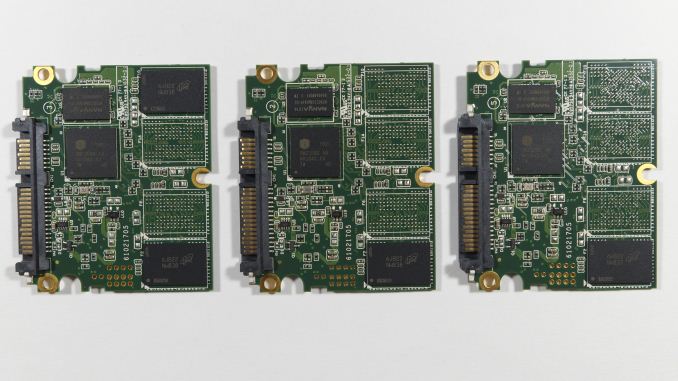The ADATA Ultimate SU800 SSD Review (128GB, 256GB, 512GB)
by Billy Tallis on February 1, 2017 12:01 PM EST
ADATA's Ultimate SU800 is their first SSD to use 3D NAND and the first 3D NAND SSD from a company that doesn't manufacture their own NAND flash memory. The SU800 pairs Micron's 3D TLC NAND with Silicon Motion's SM2258 controller to produce an entry-level consumer SATA SSD, available in both 2.5" and M.2 form factors.
We've previously reviewed the Silicon Motion SM2258 controller in the Intel SSD 540s, which uses SK Hynix 16nm TLC NAND. We also had the opportunity to test an SM2258 engineering sample/reference design from Silicon Motion that used the same Micron 3D TLC but earlier firmware and different overprovisioning settings. Silicon Motion's controllers are known for low cost and low power, and it's worth noting that their SATA SSD controllers are one of the few remaining single-core designs.
Micron's 3D TLC is the first 3D NAND to hit the open market in high volume and with reasonable cost. For the moment, Micron's 3D NAND is the only viable option for most SSD manufacturers looking to move beyond planar NAND. Samsung is keeping almost all of their 3D NAND for their own very successful SSDs. Toshiba and SK Hynix are technically shipping 3D NAND but in limited supply and the poor cost effectiveness have prevented any third parties from adopting it for commercial SSDs. Toshiba and SK Hynix each have at least one or two token models in the supply chain using their 3D NAND, but still no mass-market consumer or retail availability. (Toshiba and SK Hynix have seen more success in the smartphone and memory card markets, where performance requirements are lower and the large die sizes of Micron's 3D NAND are a problem.)
Micron's only consumer SSD with 3D NAND so far is the Crucial MX300, and Intel has released their SSD 600p, both using the Intel/Micron 32-layer 384Gb 3D TLC NAND flash. The Crucial MX300 has been quite successful, with acceptable mainstream performance, great pricing, and great power efficiency. The Intel 600p is the most affordable NVMe SSD on the market and it offers real-world performance that exceeds any SATA SSD. That leaves plenty of room in the market for other models with 3D NAND, and plenty of interest from consumers seeking the benefits of 3D NAND.
Micron's 32-layer 3D TLC NAND has a capacity of 384Gb (48GB) per die. This odd capacity means that while the SU800 has typical usable capacities like 128GB and 512GB, the die counts and raw flash capacities aren't powers of two. The 128GB SU800 has just three packages with one die each for a raw capacity of 144GiB. The 256GB and 512GB SU800s use three and six dual-die flash packages, respectively. Since the SM2258 controller has four channels for communicating with NAND, the smallest SU800 cannot make full use of the controller's capability and has reduced performance as a result. The larger capacity SU800 variants are rated to mostly saturate SATA on sequential transfers.
| ADATA Ultimate SU800 Specifications | ||||
| Capacity | 128 GB | 256 GB | 512 GB | 1 TB |
| Controller | Silicon Motion SM2258 | |||
| NAND Flash | Micron 32-layer 384Gb 3D TLC NAND | |||
| Form Factor | 2.5" 7mm or M.2 2280 | |||
| Sequential Read | 560 MB/s | |||
| Sequential Write | 300 MB/s | 520 MB/s | ||
| Random Read IOPS | Up to 90K IOPS | |||
| Random Write IOPS | Up to 80K IOPS | |||
| TCG Opal Encryption | No | |||
| Power Management | DevSleep | |||
| Warranty | 3 years | |||
| MTBF | 2,000,000 hours | |||
| Initial MSRP | $59.99 | $79.99 | $139.99 | $269.99 |
In this review, the SU800 will be compared against the following drives. Click on the names to see their subsequent reviews.
- Micron's Crucial MX300, using the same 3D TLC NAND but Marvell's 88SS1074 controller
- Intel SSD 540s, using the same Silicon Motion SM2258 controller but SK Hynix 16nm planar TLC NAND
- ADATA Premier SP550, using the earlier Silicon Motion SM2256 controller and SK Hynix 16nm planar TLC NAND
- PNY CS1311, one of many models using the Phison S11 controller and Toshiba 15nm planar TLC NAND
- Samsung 750 EVO, Samsung's return to planar TLC for the sake of cost-cutting and to avoid the limitations of low NAND die count on low capacity SSDs due to the high per-die capacity of 3D NAND
- ADATA XPG SX930 , an older mainstream SSD using Micron 16nm MLC and JMicron JMF670H controller
As always, other comparisons can be made using our Bench database.
| AnandTech 2015 SSD Test System | |
| CPU | Intel Core i7-4770K running at 3.5GHz (Turbo & EIST enabled, C-states disabled) |
| Motherboard | ASUS Z97 Pro (BIOS 2701) |
| Chipset | Intel Z97 |
| Memory | Corsair Vengeance DDR3-1866 2x8GB (9-10-9-27 2T) |
| Graphics | Intel HD Graphics 4600 |
| Desktop Resolution | 1920 x 1200 |
| OS | Windows 8.1 x64 |
- Thanks to Intel for the Core i7-4770K CPU
- Thanks to ASUS for the Z97 Deluxe motherboard
- Thanks to Corsair for the Vengeance 16GB DDR3-1866 DRAM kit, RM750 power supply, Carbide 200R case, and Hydro H60 CPU cooler

















35 Comments
View All Comments
SaolDan - Wednesday, February 1, 2017 - link
Neat!!!MrSpadge - Wednesday, February 1, 2017 - link
Overall a worse deal than the MX300, which itself took quite some criticism. Could you elaborate on what's "neat" about this?vladx - Wednesday, February 1, 2017 - link
Price is low for decent performance. This is SATA SSD targeted towards low end and mainstream market.Great_Scott - Wednesday, February 1, 2017 - link
The MX300 is better value given the drive sizes. I'm still trying to find a replacement for the Mushkin Reactor for desktops, but the Crucial drive is my go-to for laptops currently.Arbie - Wednesday, February 1, 2017 - link
Why do you guys continually fail to mention the Mushkin Reactor 1TB MLC drive ($240 at Newegg) in your SSD comparisons? It's cheaper, faster, and probably has greater endurance.You reviewed it two years ago but have hardly mentioned it since then. It seems to be a "best buy" still.
http://www.anandtech.com/show/8949/mushkin-reactor...
But... kudos on the clickbait. You have at least as much as any other site, and of the lowest degree.
vladx - Wednesday, February 1, 2017 - link
Because Mushkin already refreshed their SSD line and the old Reactor is not manufactured anymore which means it will be gone any week now.Great_Scott - Wednesday, February 1, 2017 - link
And we will all be sad to see it go. I have a bunch of those drives, myself.Flunk - Wednesday, February 1, 2017 - link
They don't often put 2 year old drives in comparisons.Great_Scott - Wednesday, February 1, 2017 - link
That's too bad, as some context would be useful, especially considering that many people own that drive, and until recently it was still being made.Then again, a two-year-old budget drive with a very similar controller would have made the SU800 series look terrible, and we can't have that.
eek2121 - Wednesday, February 1, 2017 - link
The Mushkin Reactor is a drastically slower drive, costs about the same, and will soon disappear from retailers. It is not a competitor.